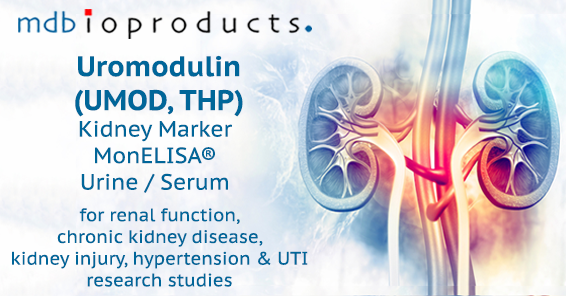
Featured Publication in Focus: On the protein content of kidney stones: an explorative study
Mar 06 , 2023
Mieke Steenbeke (UGent) , Marc De Buyzere (UGent) , Marijn Speeckaert (UGent) and Joris Delanghe (UGent)
(2022) ACTA CLINICA BELGICA. 77(5). p.845-852 Nature Communications volume 14, Article number: 691 (2023)
----------------------
Product referenced:
Uromodulin Glycoprotein (Tamm-Horsfall Glycoprotein, THP) MonELISA®
----------------------
ABSTRACT
Objectives Kidney stone formation is complex; urinary protein inhibitors play a major role in natural defense against stone formation. Using attenuated total-reflectance Fourier-transform infrared (ATR-FTIR) spectroscopy of kidney stones, proteins are usually not quantified and often reported as 'organic matrix', for which there is little attention: treatment of urolithiasis is based on the nature of the major organic/inorganic stone compound. Literature no longer regards urinary proteins as innocent bystander, but highlights the role of proteins as urolithiasis modulators. We explored the potential significance of the protein content of kidney stones. Methods 800 stones were analyzed using ATR-FTIR spectroscopy; spectra were corrected for protein content. The ratio of the amide I peak (1655 cm(-1)) divided by the maximum peak was calculated. A subgroup of stones (n = 43) was weighed; protein concentration was assayed. Kidney stone composition was taken into account when calculating protein concentration. Electrophoresis was implemented to investigate the protein bands. Multiple regression analysis was carried out to study the influence of various demographic variables (age, gender, stone type) on protein concentration. Results Protein concentration showed a marked variation according to the stone composition. High relative protein content (>0.4% stone mass) was found in mixed calcium apatite/calcium oxalate dihydrate stones, mixed calcium oxalate dihydrate/calcium oxalate monohydrate/calcium apatite stones, and mixed calcium oxalate monohydrate/brushite stones, whereas lower protein percentages were found in cystine, urate, and calcium oxalate monohydrate stones. Protein concentration was dependent of the patient's age. Conclusion ATR-FTIR is a practical way for assessing protein concentration in kidney stones.
To continue reading and to download the publication:
